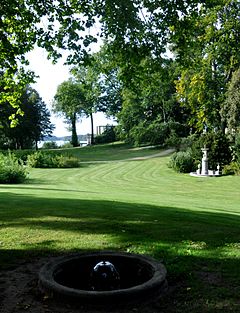Park Glienicke
| Park Glienicke | |
|---|---|
| Park Klein-Glienicke or Glienicker Park | |

|
|
| Type | English landscape garden |
| Location | Wannsee, Berlin |
| Coordinates | 52°25′0″N 13°6′0″E / 52.41667°N 13.10000°ECoordinates: 52°25′0″N 13°6′0″E / 52.41667°N 13.10000°E |
| Area | 116 hectares (290 acres) |
| Created | 1816-1870 |
| Status | Open year-round |
| UNESCO World Heritage Site | |
|---|---|
| Location |
Germany |
| Criteria | i, ii, iv |
| Reference | 532 |
| Coordinates | 52°25′00″N 13°06′00″E / 52.4167°N 13.1°E |
| Inscription | 1990 (extended in 1992 and 1999) (14th Session) |
|
[]
|
|
Park Glienicke, (German: Park Klein-Glienicke or Glienicker Park) is an English landscape garden in the southwestern outskirts of Berlin in the locality of Wannsee in the Steglitz-Zehlendorf borough. Close to Glienicke Bridge(known as Bridge of Spies) the park is open to the general public. The park is part of the UNESCO World Heritage Site Palaces and Parks of Potsdam and Berlin (Potsdam cultural ensemble). Within the ensemble it is one of the five main parks, the others being Sanssouci Park, New Garden(Neuer Garten), Babelsberg Park and Peacock Island(Pfaueninsel). Regarding diversity in gardening styles within the Potsdam park ensemble Park Glienicke is only superseded by Sanssouci Park. Furthermore, it is a park especially characterized by one personality due to the intense involvement of Prince Charles of Prussia. The park covers approximately 116 hectares (290 acres)
In 1682 Frederick William of Brandenburg, the Great Elector, commissioned the first hunting lodge Jagdschloss Glienicke next to the uninhabited village Klein-Glienicke which suffered badly in the Thirty Years' War. The lodge had a garden with four carp ponds. South of the lodge was an enclosed wildlife park; north a tree garden and two vineyards. Already since 1660 the first wooden Glienicke Bridge linked the area to Potsdam. In 1715 under Frederick William, the Soldier King, the lodge became a military hospital for soldiers to be quarantined. In 1747 the hospital head Dr. Mirow bought the tree garden and the new vineyard which were neglected since the Soldier King's death and established there an estate where besides farming kilns for bricks and lime were operated. In 1758 the lodge itself was turned into a wallpaper factory which became an orphanage in 1827. From 1789 on the Berlin-Potsdam chaussee () was built distinctly separating former lodge and new estate. The Mirow estate had different owners until the Prussian lieutenant general and head equerry Count Carl von Lindenau () bought it in 1796 and converted it into an ornamented farm./
...
Wikipedia


